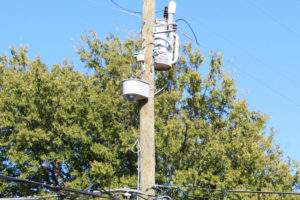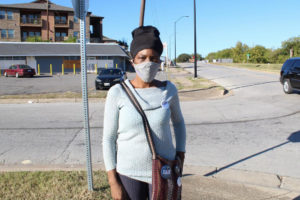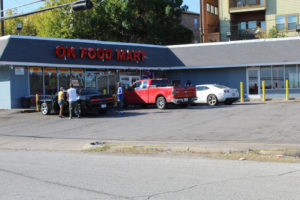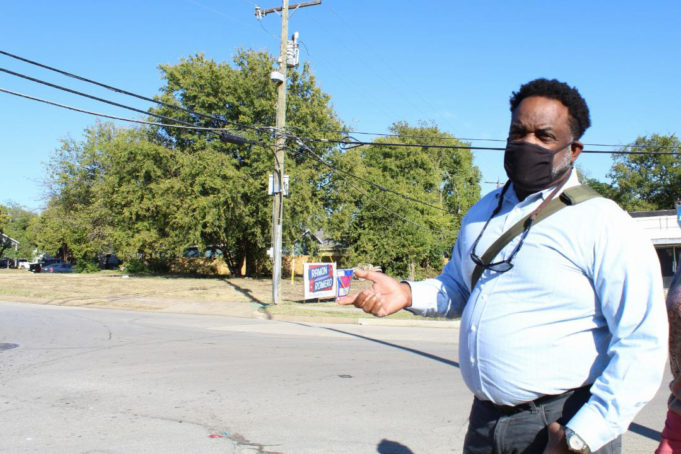Buttressed between Ridglea Hills to the west, Westover Hills to the north, and Tanglewood to the east and south, the Como neighborhood has served the surrounding white communities with domestic workers for several decades. A new generation of college-educated working professionals is reframing Como’s workforce as the neighborhood continues to benefit from its enviable location within Fort Worth.
Growth and development in Como have been mixed over the past several years, according to Leon Reed, a criminal defense lawyer. Several buildings near the intersection of Horne Street and Manhattan Drive, where I spoke with Reed and two other locals, are shuttered. Economic incentives and a booming population have spurred growth along the stretches of Bryant Irvin Road and Camp Bowie Boulevard that border Como, but once vibrant Black-owned small businesses are now a rarity within the neighborhood, Reed said.
Residents of the predominantly Black community have long been the target of over-policing, Reed said, but the recent installation of police cameras have made that daily law enforcement reality almost unbearable. Reed said a growing contingent of his clients face criminal charges because police officers, possibly several miles away, thought they detected suspicious activity. Reed said that besides being a lazy and Constitutionally precarious form of policing, the camera system lacks transparency.
Reed recently filed a Freedom of Information Act (FOIA) request through the Fort Worth Secretary’s Office to learn the number and location of the visible police cameras — not hidden cameras. Reed’s hunch is that the monitoring devices are more prevalent in predominantly minority communities and absent from Fort Worth’s wealthy, predominantly white neighborhoods like Tanglewood and Rivercrest. Reed also has questions about who is monitoring the cameras.
Rather than release the locations of the publicly viewable, tax-funded cameras, the secretary’s office asked the State Attorney General’s office for a legal brief, which is basically a request to keep important public information private through loopholes in the FOIA.

Photo by Edward Brown
Fort Worth’s use of public cameras to monitor areas with higher-than-average rates of crime is not unique. Dallas’ new Starlight program allows Dallas police department to directly monitor private business surveillance cameras. The program, which uses software to detect anomalies that may indicate criminal behavior, is also used in Chicago, Detroit, Louisiana, and other locales.
While basic information on the camera system remains hidden by city officials, the Fort Worth police department’s website noted that the recently renewed Crime Control and Prevention District (a half-cent tax that raises more than $80 million a year for the police department) allocates around $900,000 for “cameras that have and will continue to be installed in strategic areas throughout” Fort Worth, including historic Stop Six and Las Vegas Trail, two low-income neighborhoods. Upscale districts like the West 7th corridor also have police cameras, the website stated.
Fort Worth police department maintains two camera programs: active monitoring cameras and a Community Camera Program that the city says deters crime and promotes public safety. Unlike the neighborhood camera program, the community program relies on the voluntary participation of residents who register their cameras with the local police department. A database maintained by Fort Worth police department is used to locate registered cameras for criminal investigation purposes. Participants are not obligated to release video footage, even if their cameras are registered. Fort Worth police department did not respond to numerous requests for basic information about their surveillance program.
If Fort Worth leaders see a surveillance state as a replacement for boots-on-the-ground community policing, Reed said, locals will rise up against that government overreach.
“People may not know everything about their rights, but they know when you are abusing your authority,” he said. “People are just trying to live. That’s why people in Tarrant County want less government. We don’t want Big Brother.”
******
Traffic has increased in and around Como. Once unhurried Horne Street is now a busy thoroughfare where cars dash north and south through the heart of the historic neighborhood. Due to the locations of three police cameras along Horne, local resident Pam Smith said many of her neighbors have opted to avoid that stretch of road altogether. Word of random police pullovers near the cameras has spread quickly, she said.
“The cameras are diverting drivers to Littlepage [Street] and side streets,” Smith said. “People are treating Littlepage Street like Horne Street and not stopping at the stop signs. I can see them running the stop signs. It will take one person having an accident to make people look at what’s happening. That’s one of the biggest concerns I have.”

Photo by Edward Brown
With a precision honed from 16 years of defending clients from a local criminal justice system that disproportionately pulls over, harasses, and incarcerates persons of color, Reed described how something as seemingly uncontroversial as a camera fuels mistrust of police.
“This camera primarily faces this store over here,” he said, pointing to OK Food Mart, which sits on the northwest corner of Horne Street and Manhattan Drive. The police camera (basically a small tinted bubble affixed to a utility pole) was aimed at the food store and the intersection that leads customers to Horne Street.
“It’s one thing to have cameras that other stores use to help solve crimes,” he said. “Once the crime has taken place, go back and figure out what happened. I think it’s a whole separate thing to watch people and try to actively catch someone,” especially when that surveillance isn’t performed uniformly across the city.
Actions that may appear suspicious from a distance — a prolonged handshake between two Black men, someone momentarily jumping into a friend’s car, or a reach into a sock for an unidentified item — can be perfectly explainable without nefarious suppositions, Reed said.
The intersection and Texas’ traffic laws offer several opportunities for Fort Worth police to pull over Como residents. Coasting over the sidewalk without coming to a full stop, not signaling 100 feet before reaching the stop sign (an impossibility when leaving OK Food Mart), and not coming to a full stop at the stop sign could lead camera monitors to radio nearby cops to pull over unwitting food store customers.
Lifelong Como resident Tonya Carter described being pulled over after leaving OK Food Mart two months ago. Moments before Carter drove away from the store, a Black man leaned into her car to type his phone number into her phone. The man was scheduling hairdressing services, Carter said. Shortly after driving off, Carter was pulled over by a Fort Worth police officer.
“You can see what that exchange may have looked like,” she said. The officer “told me point-blank” that he pulled me over because of the camera.
If Fort Worth police justify the surveillance of Como because of high offense rates, it’s a function of over-policing, Reed said.
“It’s selective prosecution or, as some would say, selective persecution,” he said.
Police cameras are often brought at the request of community elders with the promise of lowering crime, Reed said. Councilmember Gyna Bivens welcomed the installment of 35 police cameras in Fort Worth’s East Side three years ago, for example.
“Some of the community elders may have wanted cameras” at first, Reed said. “They may not have been told how the police were going to use them. It’s one thing to say we need a camera in this store. I can tell you that this store already has plenty of cameras. When you have cameras to help solve a crime, that’s one thing. When you are using them to actively police people, they don’t want their family members being stopped and harassed. If you are going to use the cameras in that manner, then you’d better be using them citywide. Don’t drop 100 cameras in lower-income neighborhoods.”
Reed said the same fair standards that govern other aspects of life should apply to Black communities.
“Referees don’t blow the whistle on fouls that they think happened,” Reed said. “They blow the whistle on fouls that they saw happen. In our community, they keep blowing the whistle because they think someone committed a foul. Blow the whistle when you see that a foul was committed. Don’t guess at it. Don’t call it from the backside. It frustrates citizens in the community.”
Max Krochmal, author and associate professor of history at TCU, said over-policing in Como is the result of decades of public policy decisions that suppressed economic development in the historic neighborhood.
“We know Como was built as a white resort neighborhood that [relied on] Black domestic servants,” he said. “Segregation was baked into the area by design. White wealthy families there needed a labor force for jobs that were racialized and designated for Black workers. Over time, Como was encircled by ongoing development, including Ridglea Hills — a segregated white neighborhood” that built a wall to keep Como residents out.
As the population in Como became predominantly Black, Krochmal said bank practices deemed Black-owned homes as less valuable. Loans in Black communities came with unfavorable terms, he added.
“As a result, it becomes more difficult for people to invest in homes and neighborhoods” in Como, he said, “so the tax base is lower. Local governments saw the area as contributing less in taxes, so they provided less public services. There was a systematic disinvestment of municipal services due to the history of discriminatory lending.”
Throughout the 1960s and ’70s, federal services that addressed poverty began being replaced with increased policing, both in Fort Worth and across the county, he said.
“What was happening was a war against the expanding rights of African Americans and other people of color,” he said. “It was a counterinsurgency designed to contain the liberation struggles and to preserve the unequal status quo of the 1960s.”
Lyndon Johnson’s call for a war on crime and Ronald Reagan’s war on drugs created sentencing guidelines and policing policies that disproportionately targeted Black and brown communities, he said.
“If I was a resident in Como and saw one of these cameras or felt like I was being pulled over more often, I think there are many reasons to be suspicious about what’s going on,” Krochmal said.
This past month, I sent the Fort Worth police department several questions about their surveillance program, including basic questions about the cost and the purpose of the cameras. My repeated requests for information were ignored.
Speaking to Channel 8 in 2017, Fort Worth officer Daniel Segura said the cameras were installed to “follow leads, follow suspicious activity, and to help the community. We have to be careful about who has access to cameras. Only command staff and specific personnel” can monitor the cameras.
*****

Photo by Edward Brown
“The surveillance society is upon us,” reads the opening line of a recent article by the American Bar Association. The article goes on to list the Constitutional concerns raised by the advent of artificial intelligence (AI) that can be coupled with existing camera systems to target individuals based on biometric analysis. The only long-term solution is national legislation to protect civil rights, the article notes.
The United States is home to tens of millions of cameras that could be weaponized to find compromising footage to blackmail politicians or for other nefarious reasons, a 2019 New York Times article said. Fort Worth police currently use license plate recognition software, according to the police department’s website.
“License plate readers have played an increasingly critical role in the transformation of policing and improving public safety,” the website said. “The Fort Worth police department has had multiple success stories utilizing this technology, aiding in the location of missing loved ones, locating kidnapping and sexual assault assailants, and other high-profile cases. The Fort Worth police department continues to invest in this technology, which has proven to be a force multiplier.”
A video made by Vigilant Solutions, a California-based surveillance corporation, uses a cartoon to show how the program catches dangerous criminals.
When automated surveillance programs are in clear sight and uniformly enforced, Texans tend to reject those programs. Last year, Gov. Greg Abbott signed a bill banning red-light cameras. Critics of red-light cameras noted that it ran afoul of the Sixth Amendment of the U.S. Constitution, which guarantees the right of defendants to be “confronted with the witnesses against him.”
The same Constitutional-rights violations potentially afflict the Fort Worth police camera program. Reed said Fort Worth’s documented history of systemic racism places the burden on police to prove that their cameras are not disproportionately targeting Black communities. Since 2001, state laws have required Texas police departments to track race-related data. Reed cites those records when describing Fort Worth’s documented racist policing habits that date back until 2001 and presumably much earlier.
Reed provided copies of the reports, which were reviewed in full. Consistent in the data is underrepresentation of white residents and substantial overrepresentation of Black residents in tallies for traffic citations and arrests. The city data frequently change reporting methodology (bar graphs, pie graphs, no graphs) from one year to the next. That decision makes comparing year-to-year changes difficult.
In 2019, Black drivers accounted for 38% of vehicle searches. In 2009, 42% of vehicles searched had Black drivers, and numbers from 2002 show that Black residents accounted for nearly 40% of Fort Worth police department vehicle stops, even though the Black community at the time accounted for only 18.5% of drivers in Fort Worth. Black drivers were significantly overrepresented across a wide range of police interactions — without exception — between 2003 and 2019, according to Fort Worth police department records.
“When you look at the raw data of African Americans who have vehicles, it’s [as low as] 14% of drivers,” Reed said. “We’re getting stopped in the 36th percentile and higher. From those stops, you are deriving citations, searches, arrests, and potential crimes. Whites are always underrepresented. These cameras are used to selectively stop [Black] people.”
Reed believes Fort Worth police frequently search the cars of Black men and women without consenting. Open warrants that result from an inability to pay off traffic tickets are grounds for continually pulling over Como residents, Reed said.
“They are keeping that warrant open so they can pull you over again,” he said. “If they find something the second time, they reverse engineer it. If they say they found weed, then it becomes, ‘Oh, I smelled marijuana, so I searched the car.’ Now, you have someone catching a criminal case in a predominantly minority neighborhood.”
The Brookings Institution, a nonpartisan American think tank, found little variation in marijuana use by race. In Tarrant County, Black and Latinx defendants constituted nearly two-thirds of misdemeanor charges for possession of under two ounces of marijuana last year. Black men and women are arrested for marijuana possession at more than twice the rate of whites. Lopsided policing practices and a complicit district attorney’s office create statistics that are then used to validate over-policing, Reed said.
Como residents take crime seriously, Reed said. The tight-knit community has a long history of calling out bad actors within the neighborhood. The best deterrents of crime are engaged police officers who participate in community events and build trust with elders, children, and everyone in between, Reed said.
“Go to the little league games and show the kids that you are interested in them, and you’re not fake about it,” he said. “Everyone knows everyone’s families here. We want Como to be around for a long time. Our church wants to remain here.”
Reed believes that he will ultimately be successful in gaining the locations of the publicly viewable police cameras. He is asking for the camera locations from specific dates so city officials or police can’t fudge the numbers by installing cameras in predominantly white neighborhoods after the fact.
“They are over-policing us, and they are still wondering why there is distrust between people of color and the Fort Worth police department,” he said.













Great article. I sit on the Chiefs Advisory Board and am aware of the camera’s but certainly unaware of any misuse or mistrust that they might be causing. Thanks for relaying the concerns of the community.
Now you’re aware